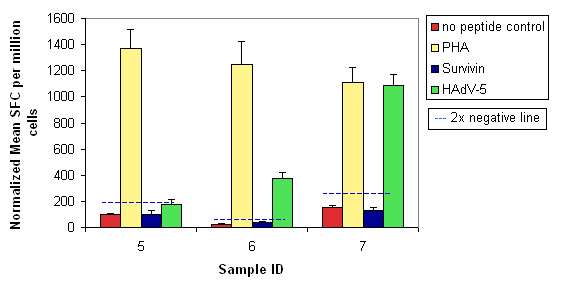Your basket is currently empty!
First-ever
Case Study:
First ever tumor-specific response observed for human patients in oncolytic adenovirus cancer gene therapy study
Cerullo, P. et. al. (2010). Oncolytic adenovirus coding for granulocyte macrophage colony-stimulating factor induces antitumoral immunity in cancer patients. Cancer Research. 70: 4297-4309. [PubMedID: 20484030]
Dr. Vincenzo Cerullo et al. at the University of Helsinki in Finland carried out this study to investigate cancer gene therapy using oncolytic viruses.
Patients were treated with an oncolytic adenovirus expressing human granulocyte macrophage colony-stimulating factor (GM-CSF) driven by the viral E3 promoter to bind the expression of the transgene to adenovirus replication, and hence to the tumor environment.
PBMCs from patients were isolated before and after the treatment and Interferon-gamma (IFN-gamma) ELISPOT was performed to assess whether the adenovirus treatment elicited a tumor-specific response in addition to oncolysis.
In order to have a “triple blind”, unbiased and professional analysis, the ELISPOT assays were outsourced to ProImmune’s cellular analysis core facility service.
Twenty-three PBMC samples from cancer patients were supplied and ProImmune carried out IFN-gamma ELISPOT assays to determine the cytokine response to Survivin and HadV-5 ProMix™ peptide pools. The Survivin (BIRC5 PONAB) peptide pool consisted of 33 peptides, the HAdV-5 Penton peptide pool consisted of 140 peptides; the peptides in each pool were 15 amino acids long and overlapped by 11 amino acids.
Cell samples were analyzed in triplicate in the IFN-gamma ELISPOT assay to determine their potential to respond to antigen stimulation; spots were counted using an automated ELISPOT plate reader. The number of spot-forming cells (SFC) for IFN-gamma cytokine secretion from test wells were counted and adjusted to SFC per million total cells. A sample result from one patient is shown graphically (figure 1). Results from test wells were compared to those for cells that were not stimulated (no peptide/negative control), and to those for cells stimulated with phytohemagglutinin (PHA, positive control). A positive result is deemed significant if it is greater than or equal to twice the negative result (indicated by a blue dashed line on the graph).
Figure 1:

The results showed that in some patients the virus treatment was able to stimulate a tumor-specific immune response to some degree. This was the first time that such a response had been observed in human patients treated with an oncolytic adenovirus.
Regarding the outsourced ELISPOT service from ProImmune, Dr. Cerullo commented “From the planning of the experiment until the end we were guided with extreme professionalism and a high quality of technical assistance”.
